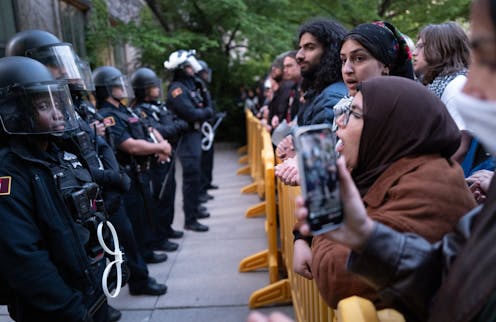
Every so often, a cause ignites a sustained fury on college campuses across the nation. In 2020, it was Black Lives Matter. In 2011, it was Occupy Wall Street. In the 1980s, it was apartheid in South Africa. Right now, it’s the Israeli military campaign in Gaza.
Since college protests tend to draw comparisons to the 1960s, it’s helpful to know more about that heritage. Here are five books about the history of campus demonstrations:
‘America Divided: The Civil War of the 1960s’
Oxford University Press
This primer on the politics and history of the 1960s recounts the Cuban missile crisis and moves through the many events that led to and fueled student activism, including the Vietnam War and key moments in the Civil Rights Movement.
Published in 1999 and now in its fifth edition, it is co-written by Hamilton College history professor Maurice Isserman, who studies leftist movements, and Michael Kazin, a Georgetown University expert on U.S. politics and social movements in the 19th and 20th centuries.
‘Harlem vs. Columbia University: Black Student Power in the Late 1960s’

University of Illinois Press
Given how prominent the Columbia demonstrations have been this year, it’s worth delving into the impact of a historically white, male bastion like the Ivy League school that abuts New York’s Harlem.
Stefan M. Bradley’s 2009 history focuses on the intertwined rises of Black and student power in response to Columbia’s attempt to build a largely segregated gymnasium in the small green park that separates it from Harlem.
‘Freedom’s Orator: Mario Savio and the Radical Legacy of the 1960s’
 Oxford University Press
It took until 2009 for someone to write a definitive biography of Savio, a visionary who sensed how campus protests could change America.
But New York University historian Robert Cohen’s 544-page tome, based on personal papers, recordings of speeches and countless interviews, brings to life accomplishments of a major leader of the Berkeley Free Speech Movement. His “Bodies Upon the Gears” speech in 1964 could easily be adopted as the mantra of today’s pro-Palestinian movement.
‘The New Student Activists: The Rise of Neoactivism on College Campuses’
Oxford University Press
It took until 2009 for someone to write a definitive biography of Savio, a visionary who sensed how campus protests could change America.
But New York University historian Robert Cohen’s 544-page tome, based on personal papers, recordings of speeches and countless interviews, brings to life accomplishments of a major leader of the Berkeley Free Speech Movement. His “Bodies Upon the Gears” speech in 1964 could easily be adopted as the mantra of today’s pro-Palestinian movement.
‘The New Student Activists: The Rise of Neoactivism on College Campuses’
 Johns Hopkins University Press
Months before the murder of George Floyd sparked BLM protests and years before Hamas attacked Israel, Villanova education professor Jerusha O. Conner published her examination of how 1960s-style activism had returned to college campuses.
Still, her examination of the current generation of student activists helps explain why they’ve been so effective at drawing attention and making change. Among other misconceptions, she debunks the myth that student activists today are fragile “snowflakes” operating from a sense of entitlement.
‘The Channels of Student Activism: How the Left and Right Are Winning (and Losing) in Campus Politics Today’
Johns Hopkins University Press
Months before the murder of George Floyd sparked BLM protests and years before Hamas attacked Israel, Villanova education professor Jerusha O. Conner published her examination of how 1960s-style activism had returned to college campuses.
Still, her examination of the current generation of student activists helps explain why they’ve been so effective at drawing attention and making change. Among other misconceptions, she debunks the myth that student activists today are fragile “snowflakes” operating from a sense of entitlement.
‘The Channels of Student Activism: How the Left and Right Are Winning (and Losing) in Campus Politics Today’
 University of Chicago Press
For a more contemporary look at student activism, pick up this slim volume by Johns Hopkins sociologist Amy J. Binder and Northern Illinois University sociologist Jeffrey L. Kidder that analyzes how the well-funded national conservative movement is building its own army of campus activists to remarkable effect.
The authors argue that voices from the left and the right are being “channeled into two distinct forms of mobilization and why that has profound consequences for the future of American politics.”
References^ Black Lives Matter (www.businessinsider.com)^ Occupy Wall Street (www.nytimes.com)^ was apartheid in South Africa (www.aamarchives.org)^ recounts the Cuban missile crisis (global.oup.com)^ Maurice Isserman (www.hamilton.edu)^ Michael Kazin (gufaculty360.georgetown.edu)^ delving into the impact (www.press.uillinois.edu)^ Stefan M. Bradley’s (www.amherst.edu)^ write a definitive biography (global.oup.com)^ Robert Cohen (steinhardt.nyu.edu)^ Bodies Upon the Gears” speech (ushistoryscene.com)^ Jerusha O. Conner (www1.villanova.edu)^ published her examination (www.press.jhu.edu)^ pick up this slim volume (press.uchicago.edu)^ Amy J. Binder (soc.jhu.edu)^ Jeffrey L. Kidder (www.niu.edu)Authors: Steve Friess, Independent writer and editor, University of Michigan
University of Chicago Press
For a more contemporary look at student activism, pick up this slim volume by Johns Hopkins sociologist Amy J. Binder and Northern Illinois University sociologist Jeffrey L. Kidder that analyzes how the well-funded national conservative movement is building its own army of campus activists to remarkable effect.
The authors argue that voices from the left and the right are being “channeled into two distinct forms of mobilization and why that has profound consequences for the future of American politics.”
References^ Black Lives Matter (www.businessinsider.com)^ Occupy Wall Street (www.nytimes.com)^ was apartheid in South Africa (www.aamarchives.org)^ recounts the Cuban missile crisis (global.oup.com)^ Maurice Isserman (www.hamilton.edu)^ Michael Kazin (gufaculty360.georgetown.edu)^ delving into the impact (www.press.uillinois.edu)^ Stefan M. Bradley’s (www.amherst.edu)^ write a definitive biography (global.oup.com)^ Robert Cohen (steinhardt.nyu.edu)^ Bodies Upon the Gears” speech (ushistoryscene.com)^ Jerusha O. Conner (www1.villanova.edu)^ published her examination (www.press.jhu.edu)^ pick up this slim volume (press.uchicago.edu)^ Amy J. Binder (soc.jhu.edu)^ Jeffrey L. Kidder (www.niu.edu)Authors: Steve Friess, Independent writer and editor, University of MichiganRead more




